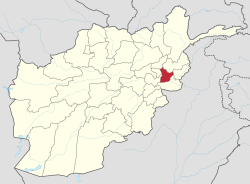Laghman Province
|
Laghman لغمان |
|
|---|---|
| Province | |

Lush greenery stands in stark contrast to the surrounding desert in Laghman Province
|
|
 Map of Afghanistan with Laghman highlighted |
|
| Coordinates (Capital): 34°40′N 70°12′E / 34.66°N 70.20°ECoordinates: 34°40′N 70°12′E / 34.66°N 70.20°E | |
| Country |
|
| Capital | Mihtarlam |
| Government | |
| • Governor | Dr Abdul Jabbar Naeemi |
| Area | |
| • Total | 3,842.6 km2 (1,483.6 sq mi) |
| Population (2015) | |
| • Total | 445,588 |
| • Density | 120/km2 (300/sq mi) |
| Time zone | UTC+4:30 |
| ISO 3166 code | AF-LAG |
| Main languages |
Pashto Dari Pashayi |
Laghman (Pashto/Persian: لغمان) is one of the 34 provinces of Afghanistan, located in the eastern part of the country. It has a population of about 445,600, which is multi-ethnic and mostly a rural society. The city of Mihtarlam serves as the capital of the province. In some historical texts the name is written as "Lamghan" or as "Lamghanat".
Located currently at the Kabul Museum are Aramaic inscriptions that were found in Laghman which indicated an ancient trade route from India to Palmyra.Aramaic was the bureaucratic script language of the Achaemenids whose influence had extended toward Laghman. During the invasions of Alexander the Great, the area was known as Lampaka.
Inscriptions in Aramaic dating from the Mauryan Dynasty were found in Laghman which discussed the conversion of Ashoka to Buddhism.
In the seventh century, the Chinese pilgrim Xuanzang visited Laghman, which he called "Lan-p'o" and considered part of India. He indicated the presence of Mahayana Buddhists and numerous Hindus:
"For several centuries the native dynasty had ceased to exist, great families fought for preeminence, and the state had recently become a dependency of Kapis. The country produced upland rice and sugar-cane, and it had much wood but little fruit; the climate was mild with little frost and no snow. [...] There were above ten Buddhist monasteries and a few Brethren the most of whom were Mahayanists. The non-Buddhists had a score or two of temples and they were very numerous."
By the tenth century, Laghman was still connected to the Greater Indian world. Hudud al-'alam which was finished in 982 AD mentioned the presence of some idol worshipping temples in the area. According to Muslim historian al-Utbi, the region was converted to Islam towards the end of the tenth century by the Ghaznavids, led by Abu Mansur Sabuktigin:
...
Wikipedia
